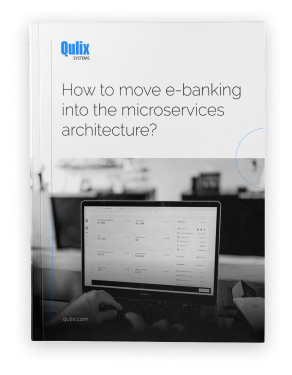As Statista writes, in 2023, the transaction value in the neobanking segment was projected to reach $4.5 trillion, and by 2027, the number of users is expected to amount to 380 million. This information raises many questions — from “What is so special about neobanks that people leave traditional banks and rush to use them?” to “How to start a neobank?” As you can see, neobank development seems like the apple of the online banking services' eye, and to own a neobank means to be at the forefront of the finance industry. So let's find out what's so neo about these banks, and how to build one!
written by:
Alexander Arabey
Director of Business Development
Contents
What Is a Neobank?
If you want to get answers to big money questions, it’s best to turn to Forbes. As Forbes informs us, “Neobanks are fintech firms that offer apps, software and other technologies to streamline mobile and online banking. These fintechs generally specialize in particular financial products, like checking and savings accounts. They also tend to be more nimble and transparent than their megabank counterparts, even though many of them partner with such institutions to insure their financial products.” Fintech both here and in general refers to the part of the finance world that employs technology (artificial intelligence, blockchain, Internet of Things, cloud, etc.) to deliver modern solutions to users, thus focusing on the improvement of customer experience.
To give you a more profound understanding of what neobanks are and how they function, let's take a look at their differences from other financial institutions.
Neobanks vs. Digital Banks
You might think that a neobank and a digital bank are interchangeable terms. However, let's end this confusion right here and now: digital banking is a mix of conventional banks and the Internet, and it provides regular banking services via websites and/or mobile apps. Often times it's a subdivision or a unit of a bigger traditional bank. Neobanks, on the other hand, “are completely digital, existing independently to traditional banks.”
Neobanks vs. Traditional Banks
Criteria
Traditional Banks
Neobanks
Presence
Have physical branches.
Online-only.
Technology
These banks use outdated solutions: the quick adoption of new technology isn't feasible because of their large-scale corporate systems.
Things like AI and blockchain are a norm.
Regulations
Any traditional bank keeps to the letter of the law through the Central Bank and must have a banking license.
Neobanks obey the rules of the Central Bank and the Ministry of Finance and can operate without a banking license (i.e., via payment and/or financial certification). Also, they can partner up with existing banks and use their license and infrastructure.
Fees
Have higher fees.
Lower fees: there are no physical branches and corresponding operating costs of running them. Also, they often don't charge fees for account maintenance, money transfers, etc.
Primary Goals
Traditional banks aim at providing as many services as possible to cater to the needs of industries and companies of all sizes. As a service provider, they deliver one-size-fits-all solutions.
Neobanks offer the most common banking services: account operations, wealth management, investments, deposits, loans, etc. On top of that, they work with cryptocurrencies and crowdfunding, just like regular banks do. However, their goal is to meet the needs of a niche target audience and solve their specific issue with a few customized services.
Now, when we know the basics, let's explore the key benefits of neobanks to inspire you to build one.
Why Would You Build a Neobank? 5 Features to Get You Excited
#1. Access from Anywhere, Anytime
No more standing in lines and visits to physical branches: there's no brick-and-mortar, folks! For financial management, all that neobank users need is a device with Internet access.
#2. Customer Support 24/7
That's the thing about neobanks — they have the potential to always be there for you, even if you get a question about currency exchange at 3 a.m. on a random Saturday. Live chats are just a screen tap away.
Nevertheless, many neobank owners underestimate the value of good customer support and how far it can take their business. As Insider Intelligence writes, “Neobank users reported the most points of pain when seeking problem resolution services via email or secure online messaging.” So it is definitely your call to seize every opportunity that these flexible financial institutions offer and craft top-notch customer experience for your users to make your product shine.
#3. Technology Allows for Incredible Flexibility and Competitiveness
Unlike regular banks, neobanks do not rely on legacy IT systems. They are crafted with the understanding that the world is constantly changing, and to be part of it, you have to adjust quickly. That's why:
- It is completely up to you how you're going to approach the neobank development process, starting with key features and finishing with how you interact with customers;
- The majority of neobanks are built on the containerized methodology. It helps to quickly and easily scale, manage, and deploy application improvements and new services. Thus, neobanks can meet the emerging market (i.e., customer-centric) demands better, preserve a competitive edge, and attract customers as well as investors.
#4. Affordability with No Borders
Since no modern neobank abides by the same set of laws as a regular bank does, it is much easier for them to join the international banking industry. Thus, they can offer their services to citizens of various countries at reasonable prices, like we discussed above. This appeals to customers and allows neobank services providers to join the global market (as long as they take care of local regulations, which we will see into below).
#5. They Are Hyper-Personalized, and Hyper-Personalized Is the “It” of Modernity
We all want to be taken care of, even when we interact with the finance industry. However, it can often be impersonal and confusing. Thus, if you'd like to provide your customers with top-notch customer service that will be about them, you should engage in neobank software development right away.
Like we said above, neobanks focus on providing digital banking services to a specific audience, getting inspired by how they can simplify lives of a certain ethnic, professional, demographic, or other group. Here are a few niche neobank examples for you:
- Majority for migrants;
- W1TTY for Gen Z;
- Nerve for musicians;
- Oxygen for freelancers;
- GoHenry for children, and many more.
As you can see, you can create a neobank app for absolutely anybody, and that unique offer of yours will be the reason people rush to open bank accounts at your financial institution. There are more niches to fill, folks, so let's get busy!
What Is a White-Label Neobank? Developing a Neobank from Scratch vs. a White-Label Neobanking Platform
Before we get to the steps you need to follow to build a neobank, let's compare these two approaches to neobank development:
Development from Scratch
White-Label Development
Development from scratch consumes a lot of time and money and requires a great team of experts.
White-label development refers to pre-built and branding-free products from other companies that you can position as your own. They are cheaper than custom products, and you can start using them ASAP after the purchase.
It costs from $350,000 to $1 million to start a neobank from scratch: you have to buy APIs and software licenses, pay the staff, etc.
White-label solutions cost from $65,000 to $500,000. You get to apply third-party licenses, certifications, modular microservices, KYC/AML compliance, and more.
You will have full control over the product, be flexible about marketing, get the chance to build your own architecture, and use the latest technologies.
White-label products present a risk of not complying with regulations and aren't always reliable: an external library may contain malware. Also, since you neither built the platform nor own it, it might be difficult to implement changes: the producer or distributor has to agree on them. You get less freedom in product marketing.
To prove that you can build a well-rounded neobank yourself, we're going to focus on how to develop it from scratch.
Neobank Development Guide: How to Be a Success?
Stage 1. Preparation
Concept Definition
It’s never enough to stress how vital it is to define the unique offerings of your product and decide on your target audience. What is your “killer feature”? How are you going to sell it to your potential customers? Unless you have a clear understanding of the neobank you'd like to develop and appropriate positioning, you won't succeed.
Bank Negotiations for Ultimate Legislation
A proper bank partner is your key to international markets: each country has its laws that regulate neobanking. Thus, the right partner with the right license will help you reach destinations that draw your attention. Additionally, after you make an agreement with an existing bank, you're free to apply its license and back-end IT layer (core, processing, KYC, etc.).
It's best to hire a compliance office who specializes in fintech to take care of this matter.
Definition of Business Processes and Estimation of Operating Costs
The general operating costs include taxes and services of lawyers and accountants. There’s also the tech side: cloud capacities, software subscriptions, a dev team, and user acquisition.
Gather Your Team
Usually, a neobank team consists of a product manager, a system analyst, a UI/UX designer, a chief security officer, and a lawyer. A project manager is an optional role that a product manager or a dedicated person can perform.
Your engineering team might include:
- 1 tech lead (architect);
- 2 front-end developers (web interfaces);
- 2–4 mobile developers (mobile apps);
- 2+ back-end developers (often even 5 to 8 people);
- 2–3 QA engineers;
- 1 DevOps engineer.
*Find out how to hire developers for your startup on our blog.
UX/UI Design Concept
Do not go overboard with visuals. To create a complex design concept and then craft it, you need significant time and monetary resources. Direct all efforts towards software development and marketing campaigns. A wise distribution of assets will pay off.
MVP Scope Description
MVP stands for a minimum viable product, and its goal is to help you understand what minimum set of critical features your neobank app should have to attract early adopters, and what additional features you can implement later on. This info is highly valuable to the stakeholders of your project, too, since they will see if your platform has the potential to make money.
Here's an example of an MVP scope, or a set of key features for a compelling neobanking platform:
- KYC and new user registration/onboarding;
- Card order/delivery;
- My products (accounts/cards, etc.) and relevant operations;
- Statements/transaction history;
- Money transfers (between products, C2C, C2A);
- Utility bills;
- Notifications.
Your software solution can and should have advanced neobank features, too. You are free to provide various services to protect customer data, educate customers on personal financial management, and make user experience seamless:
- Biometrics (such as voice recognition) and two-factor authentication as the main security measures against fraud;
- Cashback. You can choose a certain category of services or goods that would allow users to get some money back;
- Gamification. For example, in the ZA Bank App, you can play a PowerDraw game for a chance to win a huge cashback for offline purchases;
- Dynamic CVV2. This is a feature that helps secure your finances and transactions when you don't have your credit card with you;
- Personal finance management. Your platform can offer to set savings goals and provide educational tips on how to achieve them;
- Cryptocurrencies. Since both the number and the popularity of cryptocurrencies continue to grow, this could be a great addition to your app;
- ATM integration into the omnichannel system. We suggest to develop a mobile app first (for cost- and time-efficiency), and then move on to other channels like ATMs to ensure your product's accessibility;
- Referral program. Inspire customers to invite their friends to your neobank. Reward them with bonuses or cashback for spreading the word and helping you grow the audience.
- Online chat. Let your customers talk to support teams: if they know that you are always within their reach, their loyalty and satisfaction with your services will grow.
- Chatbots. Just like an actual support team, chatbots can provide assistance with the most common issues and questions. Also, while your customers are being taken care of by virtual assistants, your support specialists can concentrate on more difficult tasks that require human input.
When the time for the MVP scope description comes, the team should define a tech stack. Here's a tip: your neobank platform should have an open-source code (no vendor lock-in) and the common stack of technologies (e.g., Java + React).
For security measures, we suggest using such AWS tools as AWS Shield (to prevent DDoS attacks) and AWS config firewall rules (which protects against accidental coding errors).
A few words about KYC: as Unit21 writes, “Many sponsor banks or banking as a service providers will recommend a KYC/KYB vendor that they frequently use (and trust). You should definitely look into this vendor and compare them to other vendors you’re looking at, as they likely have a good relationship with the sponsor bank — which should make your relationship with them easier as well.”
Stage 2. PoC Implementation
PoC stands for Proof-of-Concept, so this stage is all about rapid prototyping. The goal of this process it to define whether developers can realistically implement core features of your project. It also ensurers that the user experience you had in mind will work for your target audience.
We recommend implementing one or two vertical scenarios involving all layers (including those from the bank partner). For example, user login + an option to get the info about the products.
Stage 3. MVP Implementation
Now, it's time to build the foundation of a neobank platform that will glue the glances of early adopters to its fantastic self. Like we explained above, you'd better not implement advanced features here, only the remaining functionality from the MVP scope. Why? From our experience, 10% of the functionality may require up to 90% of time, so you would rather not waste valuable resources on something that insignificant at such an early development stage. Nevertheless, many business owners and stakeholders neglect this step and launch the final product without ever getting market feedback, which leads to very grim business consequences.
Develop the core of your neobank app and test it in a sand-box. Also, get busy with pre-production, since the time for deployment is getting nearer. By the way, since in this day and age we mostly deploy services in the cloud, you don't have to purchase servers and other equipment. Just choose a deployment option 2–3 months after you initiated the project to have all the necessary papers ready by the release time. You can go for a public, private, or hybrid cloud*, as well as a cloud services provider, e.g., AWS or Microsoft Azure.
*If you'd like to learn more about different cloud deployment options, feel free to check out this article.
Stage 4. Market Release
The job is done, now you're a citizen of the digital banking world and own a neobank! Release the product, get feedback, and fix bugs. And remember: the work on your neobank platform will never stop, so it is essential to keep an eye on the market for the emerging trends and further improve your product to ensure its relevancy and quality.
FAQs
To sum up everything we’ve talked about above, we invite you to take a look at the brief answers to the hottest questions about neobanking.
#1. Does a neobank need a license?
Not necessarily. You can partner up with an existing bank and use theirs.
#2. What is the purpose of a neobank?
To provide digital-only, mobile-first financial solutions.
#3. What is an example of a neobank?
To name a few, Chime, W1TTY, Varo, Current, Aspiration, Nerve, and Oxygen.
#4. What is a neobank vs. fintech?
Fintech describes the sector of the financial industry that widely utilizes technology, whereas a neobank is a new kind of fintech institution.
#5. What is the difference between a digital bank and a neobank?
Digital banks are a combination of regular banks and the Internet, whilst neobanks are technology's brainchildren, which provide personalized banking services.
#6. How much does it cost to start a neobank?
As always, it is possible to put a price tag on it only after discussing your specific project. On average, the prices of white-label neobanks vary from $65,000 to $500,000, and neobanks from scratch cost from $350,000 to $1 million.
#7. How do you create a neobank?
To start a neobank, you need to define its concept, think through the expenses, hire a development team, implement the PoC and MVP, and launch the product!
#8. Is Amazon Pay a neobank?
No, it's not. It's an online payment service that allows customers to make purchases in a store online by using payment and shipping information from their Amazon accounts.
#9. Going to develop a neobank? White label vs. development from scratch.
While white-label neobanks allows launching your product quicker and at a lower cost, development from scratch helps you maintain control over your neobanking platform and adjust it with ease, speed, and in accordance with the latest tech & market trends.
Start Thinking ✨ Neo ✨
It's a big step to start a neobank. But it's easier to take it when you know what lies ahead of you, like you do now. Just keep in mind that neobank development rests on three whales: a great bank partner, a fantastic engineering team, and a clear description of business processes. If you've got all three, you'll be just fine.
By the way, we've been exploring the ocean for quite some time now and know hundreds of majestic whales! Contact us if you'd d like to start a neobank and need some support!

Contacts
Feel free to get in touch with us! Use this contact form for an ASAP response.
Call us at +44 151 528 8015
E-mail us at request@qulix.com










